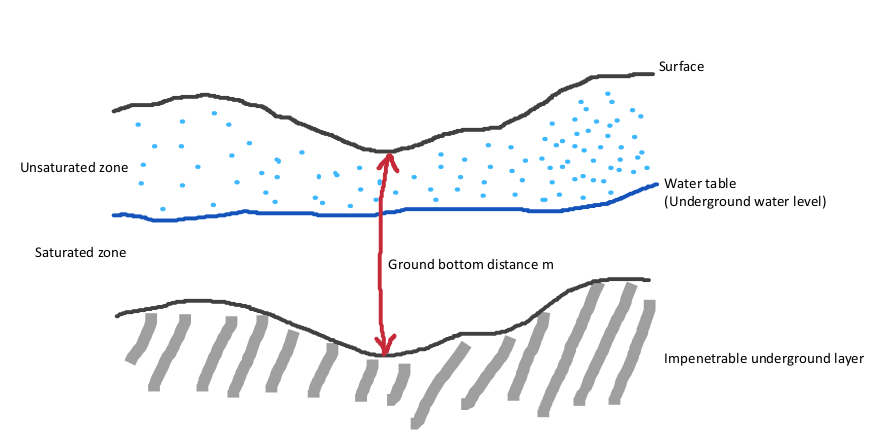Ground model (Water Overlay)
The Water Module also contains a simplified 2-layer underground model, for infiltration, evaporation and horizontal flow in the underground. Additionally, the model also applies a simplified form of exfiltration of water from the soil back onto the surface layer.
Only groundwater overlays activate the underground model by default. If the underground model is not active, water can not infiltrate, exfiltrate, evaporate or flow in/from the underground. Other water overlays can activate the underground model by adjusting the value of the GROUND_WATER attribute to 1.
The assumption is made that underground is bound vertically by the surface of the terrain at the top and by an impenetrable layer at the bottom. The distance between the surface and the impenetrable layer, and thus the effective height of the underground, is equal to GROUND_BOTTOM_DISTANCE_M. In other words, the impenetrable underground layer is assumed to be a set distance below the surface. The distance is uniform across the entire project area, and therefore follows the profile of the surface.
The fraction of water the underground can store per volume is defined with the WATER_STORAGE_PERCENTAGE attribute of the underground layer terrain.
Furthermore, the underground is composed of 2 layers: the unsaturated zone and the saturated zone. The saturated zone is the region of the underground where the soil is saturated with water. The unsaturated zone is the region of the underground above the saturated zone. The edge between the unsaturated and saturated zone is defined as the groundwater level.
The groundwater table is the datum height of the top of the saturated zone. The amount of water in the saturated zone is determined with the datum height of the groundwater table, the datum height of the surface, the GROUND_BOTTOM_DISTANCE_M and the underground terrain's WATER_STORAGE_PERCENTAGE.
Initialization
The underground water level is initialized with the values of the ground water GeoTIFF connected to the water model. If no ground water data is connected, the ground water level relative to datum is equal to the surface water level relative to datum, as defined by the WATER_LEVEL attribute of the water level area in that location.
Vertical flow
Vertical underground water flow is modeled as infiltration and described in the subsequent model.
Horizontal flow and aquifers
The underground flow is implemented using formulas described in Harbaugh 2005[1]. See the image to the right. Two adjacent cells, where underground water level of cell 1 is larger than cell 2. The flow between the two cells is calculated as:
- Δw = w1 - w2
- Bex = max ( B1 , B2 ) - Dground
- Ac = Δx * ( wavg - Bex )
- C = min(C1 , C2 )
- q = Δw * C * Ac / Δx * Δt
where:
- wn = The underground water level of cell n.
- Bn = The surface elevation of cell n.
- Cn = The ground conductance of cell n. For this we use the vertical infiltration speed.
- Dground = The configured ground bottom distance.
- Ac = Area of conductance.
- Δw = Underground water level difference.
- Δt = Computational timestep.
- Δx = Size of grid cell.
- wavg = Averaged underground water level, based on water levels in underground, underground storage fraction and potentially the surface water level, when the underground is filled to the top.
References
- ↑ Harbaugh, A.W., 2005, MODFLOW-2005, the U.S. Geological Survey modular ground-water model-the Ground-Water Flow Process: U.S. Geological Survey Techniques and Methods 6-A16, variously paginated.

